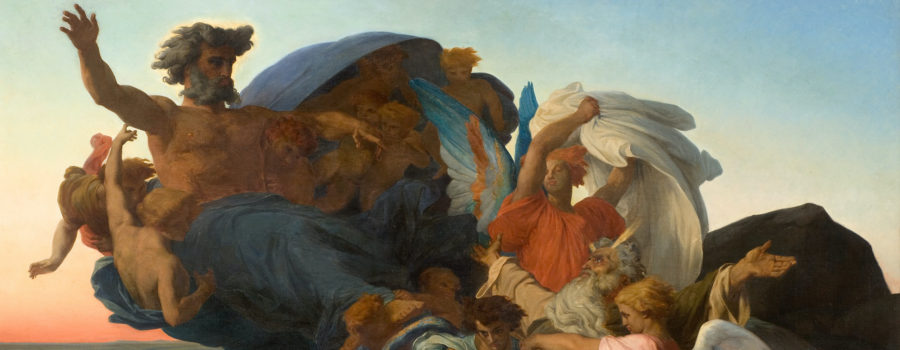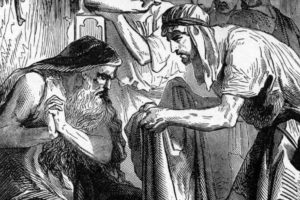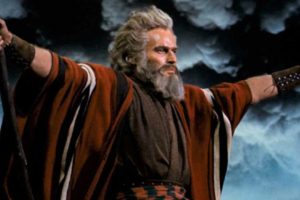In the Stick of Joseph, we read an interesting account that compares the death or ascension of Alma to that of Moshe:
And now it came to pass that after Alma had said these things to Cheleman, he blessed him, and also his other sons, and he also blessed the earth for the righteous’ sake. And he said, Thus says Adonai YHWH: Cursed shall be the land, yes, this land, unto every nation, kindred, tongue, and people, unto destruction, which do wickedly, when they are fully ripe; and as I have said, so shall it be. For this is the cursing and the blessing of Elohim upon the land, for YHWH cannot look upon sin with the least degree of allowance. And now, when Alma had said these words, he blessed the assembly, yes, all those who should stand fast in the faith from that time henceforth. And when Alma had done this, he departed out of the land of Zerach’mla as if to go into the land of Melek. And it came to pass that he was never heard of again; and as to his death or his burial, we know not. Behold, this we know, that he was a righteous man; and the saying went abroad in the assembly that he was taken up by the spirit, or buried by the hand of YHWH, even as Moshe. But behold, the scripture says YHWH took Moshe unto himself; and we suppose that he has also received Alma in the spirit unto himself. Therefore, for this cause we know nothing concerning his death and burial.
(Alma 21:3)
Interestingly, the Stick of Joseph references a group of Jewish traditions about the death of Moses that are not found in the Tanakh, but are recorded in the ancient Rabbinic literature.
For example we read in the Talmud:
…Others declare that Moses never died; it is written here, ‘So Moses died there’, and elsewhere it is written: ‘And he was there with the Lord.’ As in the latter passage it means standing and ministering, so also in the former it means standing and ministering. And He [Elohim] buried him [Moshe] in the valley in the land of Moab over against Beth-peor. R. Berechyah said: Although [Scripture provides] a clue within a clue, nevertheless no man knoweth of his sepulchre. The wicked Government once sent to the governor of Beth-peor [the message], ‘Shew us where Moses is buried’. When they stood above, it appeared to them to be below; when they were below, it appeared to them to be above. They divided themselves into two parties; to them who were standing above it appeared below, and to those who were below it appeared above. This is in fulfilment of what is said: ‘No man knoweth of his sepulchre’. R. Hama son of R. Hanina said: Even Moses our teacher does not know where he is buried; it is written here, ‘No man knoweth of his sepulchre’, and it is written elsewhere, And this is the blessing wherewith Moses the man of God blessed.
(b.Sotah 13b-14a)
And in the Midrash Rabbah we read that Moshe pleaded with YHWH saying “…remember the time when I abode on Mount Sinai for forty days and forty nights, I implore Thee, do not hand me over into the hand of the Angel of Death.”
The Midrash then says:
Thereupon a heavenly voice was heard saying to him: ‘ Fear not, I myself will attend to you and your burial.’ At that hour, Moses arose and sanctified himself like the Seraphim, and God came down from the highest heavens to take away the soul of Moses, and with Him were three ministering angels, Michael, Gabriel, and Zagzagel. Michael laid out his bier, Gabriel spread out a fine linen cloth at his bolster, Zagzagel one at his feet; Michael stood at one side and Gabriel at the other side. God said: ‘ Moses, fold your eyelids over your eyes,’ and he did so. He then said: ‘Place your hands upon your breast,’ and he did so. He then said: ‘ Put your feet next to one another,’ and he did so. Forthwith the Holy One, blessed be He, summoned the soul from the midst of the body, saying to her: ‘My daughter, I have fixed the period of thy stay in the body of Moses at a hundred and twenty years; now thy end has come, depart, delay not.’ Whereupon she replied: ‘Master of the Universe, I know that Thou art the God of all spirits and all souls, the souls of the dead and the living are in Thy keeping, and Thou hast created and formed me and placed me within the body of Moses for a hundred and twenty years. And now, is there a body in the world purer than the body of Moses in which there has never been an offensive smell, nor worm nor maggot, nor any kind of vermin; therefore I love him and I do not desire to leave him.’ Whereupon God exclaimed: ‘Soul, go forth, do not delay, and I will raise thee to the highest heavens and will place thee under the Throne of Glory next to the Cherubim, Seraphim, and other troops of angels.’ Thereupon the soul replied: ‘Master of the Universe, two angels, Uzah and Azael, came down from near Thy divine Presence and coveted the daughters of the earth and they corrupted their way upon the earth until Thou didst suspend them between earth and heaven. But the son of Amram from the day Thou didst reveal Thyself unto him at the Bush has had no marital relations with his wife,’ as it is said, And Miriam and Aaron spoke against Moses because of the Cushite woman whom he had married; for he had married a Cushite woman (Num. XII, 1). ‘I implore Thee let me remain in the body of Moses.’ Thereupon God kissed Moses and took away his soul with a kiss of the mouth, and God, if one might say so, wept [as it is said], Who will rise up for me against the evil-doers? Who will stand up for me against the workers of iniquity? (Ps. XCIV, 16)
(Deut. Rabbah XI:10)
And the Zohar twice records a tradition that Moshe never actually died:
“Moses did not die, but he was gathered in from the world…”
(Zohar 1:37b-38a)
“For Moses did not die. But is it not written, ‘And Moses died there’? The truth is, however, that although the departure of the righteous is always designated ‘death,’ this is only in reference to us. For over him who has attained completeness, and is a model of holy faith, death has no power, and so he does not, in fact, die”
(Zohar 2:174a).
The Stick of Joseph writers believed Moshe was either “taken up by the Spirit” or that he was “buried by the hand of YHWH”. In fact, both of these ancient Jewish traditions are found in the ancient Jewish literature, but neither are found in the Tanak, once again testifying to the fact that the Stick of Joseph is, after all, an ancient Jewish book.





Leave a Reply